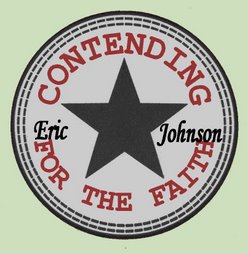Jesus and Justification
In my recent studies and conversations concerning justification I have come across a few bible stories that seem to show Jesus declaring someone as being forgiven. In other words, people were justified prior to the death of Christ. And the reason why I have contemplated this issue from various different angles lately is that this is such an important doctrine. It is this doctrine upon which the reformation exploded from. The understanding that at one moment in time, a sinner goes from being judged by his or her own deeds and unrighteousness, but now this same sinner is judged on the basis of Christ’s deeds and righteousness as He perfectly fulfilled the law of God. This singular event of being declared righteous on the basis of the righteousness of Christ Jesus is very different from other theological views that espouse a process of justification.
Before I go further, let me briefly illustrate why this is so vital. 2 Corinthians 5:21 says, “He made Him who knew no sin to be sin on our behalf, so that we might become the righteousness of God in Him.” If we, in the sense of process justification, become righteous over time (over time is implied and stressed in these frames of thought) by being righteous, then this verse means that Christ also became sin by being sinful.
"’In Him’, don’t miss those two last, little, explosive, words. What this teaches is that because of our union with Him, because we are ‘in Him’, we become righteous [in] the same way Jesus became sinful. How did Jesus become sinful? Did He become sinful by sinning? No, nor do we become righteous by doing righteousness. He became sinful by having God recon to His account my sin, and I become righteous by having God recon to my account, His righteousness. And if that isn’t the best news in all the world, I don’t know what is because I know that in this life, both biblically and experientially, I’m not going to ever arrive at a point where I would qualify to be accepted by God. Ever! Therefore I must have the qualification from another, and it is His. And then the question is, ‘How do I get it?’ And the answer is ‘In Christ!’ United to Jesus, my sin is on Him, his righteousness is mine, and do you then see how huge this issue is? [Do you see] how important being ‘in Christ’ is? Union with Christ is not a throw-away, minor doctrine; it is at the center [of our doctrine]."1
Let us not miss the scale of how important this doctrine is. This truth of justification as an event where the sins of the sinner are imputed to Christ and the righteousness of Christ is imputed to the sinner is the difference between complete biblical grace in salvation and every other human and demonically contrived religious system of works righteousness. This doctrine of justification is, to use a colloquialism, a hill to die on.
The story of the paralytic who was lowered through the roof of a house where Jesus was teaching and performing miracles is one of the more famous of His miracles. This account can be found in Matthew 9:1-8, Mark 2:1-13; and Luke 5:17-26, and one of the reasons that it is probably so famous is due to the extraordinary length that the paralytic’s friends went to in order that he might be placed before Jesus. The point that all three of these gospel writers seem to be making with this story has less to do with the actual healing of the paralytic but is primarily focused on Jesus’ ability to forgive the sins of men.
In all of the accounts, the man is lowered down through the roof and then Christ proclaims that this man’s sins are forgiven. The account goes on to show that Jesus shows the validity of His first statement by commanding the man, “get up, pick up your pallet and go home.” (Mark 2:11) The interesting thing is that this man was declared to be forgiven. We know that it is only on the basis of Christ’s (then future) atoning work on the cross that this is possible and that this atoning work covers all sins, this man’s justification was pronounced to all who heard, but most especially for the benefit of the Pharisees.
Another story of the healing and forgiveness of Christ, that is somewhat less well-known, is the story of the ten lepers that is found in Luke 17:11-19.2 These ten lepers came to meet Christ, but stood at a distance (as was customary with lepers). They then requested mercy from Jesus, and He responded by telling them to go and show themselves to the priests and “as they were going, they were cleansed.” (Luke 17:14) However, the point of this account is not primarily about the ten lepers who were cleansed, but about the one who was thankful. Only one leper came back to offer thanks to Jesus after he noticed that he had been cleansed of his disease. The account ends by saying, “And [Jesus] said to him, ‘Stand up and go; your faith has made you well.’” (Luke 17:19) The phrase “has made you well” literally means “has saved you.”3 Christ said that this man was saved, not that he had to become saved or that he would progressively become better in order to attain this salvation, but that he was saved by Christ in that moment. Furthermore, once we are saved, we possess eternal life (John 3:15,16; 3:36; 1 John 3:15; 5:11-13). And, by definition, eternal life cannot end, so you will not ever lose the salvation that Christ purchased and gave to you.4
On a quick side note, I think that one of the other very interesting characteristics of these two accounts of Christ saving men is that they both have another thing in common. Both stories tell us that these men were saved, that they had their sins forgiven, and both of them omit any indication that these men came seeking this outcome. Their primary goal seems to have been what the others seeking Jesus were, and that was to be healed of sickness or other physical ailments. Jesus declares that these men were saved, and it is not based on their request or their seeking Him for salvation. It seems to be an argument for the delight of God to save whosoever He wills to save, and it is not ultimately dependant upon man to seek to be saved by God.
The final account that I want to deal with today is also found in the gospel of Luke. It is the parable of the Pharisee and the Publican and how they prayed in the synagogue (Luke 18:9-13). The first interesting note is that Luke prophases the parable by saying that it was addressed to a certain group of people, “who trusted in themselves that they were righteous, and viewed others with contempt” (Luke 18:9). Jesus goes on to show how the self-righteous Pharisee compared himself to heinous sinners, even to the tax collector who was praying at the same time, and thanking God that he was not like them. However, it was the lowly sinner’s attitude in that he beat his breast and cried out for God to be merciful that Christ showed His approval for when He said, “I tell you, this man went to his house justified rather than the other.” (Luke 18:14) It was not the self-righteous attitude or actions of the Pharisee that find favor with God, it is just the opposite. It is the fact that the sinner knows and understands completely that there is absolutely nothing that he can do to please God, and that he stands totally condemned by his own actions.
It is in these passages that we glimpse one of the great doctrines and truths of all of scripture and redemptive history. This truth is the idea that justification, the once-for-all declaration of the forgiveness of sins and the righteous standing before God, is accomplished on the basis of Christ’s work alone. It is from this great and awesomely glorious truth that we can then see sanctification in its true light. The ongoing process of refining and becoming more Christ-like in our present condition (alive and redeemed, but still living in sinful flesh) is only possible when we are first made right before God.
1 “United with Christ in Death and Life” by John Piper 10/8/2000. I personally transcribed and added the information in the brackets of this transcription.
2 It is almost an entirely arbitrary personal accounting of how well known any of these stories are or aren’t. It primarily reflects my own familiarity with these stories prior to looking at them recently.
3 NASB footnotes on Luke 17:19. Also, the Greek word here has the root word that means saved in the sense of salvation.
4 There are other arguments for the perseverance of the saints (a.k.a. eternal security) that come directly from biblical texts, but my point is not to articulate those in this article. You can, however, read my thoughts on this wonderful doctrine by reading The Perseverance of the Saints (a.k.a. Once Saved Always Saved).












No comments:
Post a Comment